
The evolution of beach fashion towards more revealing styles indicates that the history of swimwear is returning to its roots.
From Simple to Complex
In ancient times, people took to the water in the nude, and the first swimsuit as a cultural expression emerged in Ancient Greece. Frescoes and drawings on amphorae from 1400 B.C. depict female figures with early prototypes of bandeau tops (strapless bras) and unexpectedly bikini-like bottoms—open swimwear consisting of narrow strips of fabric for both the top and bottom.
In Ancient Rome, the wives and daughters of patricians bathed in light swimming togas made from a semicircular piece of thin fabric wrapped around the body with a neck opening. The emergence of specialized swimwear among ancient Romans was linked to the development of water sports. The Sicilian Villa Romana del Casale features a mosaic from 300 B.C. depicting people in outfits resembling bikinis.
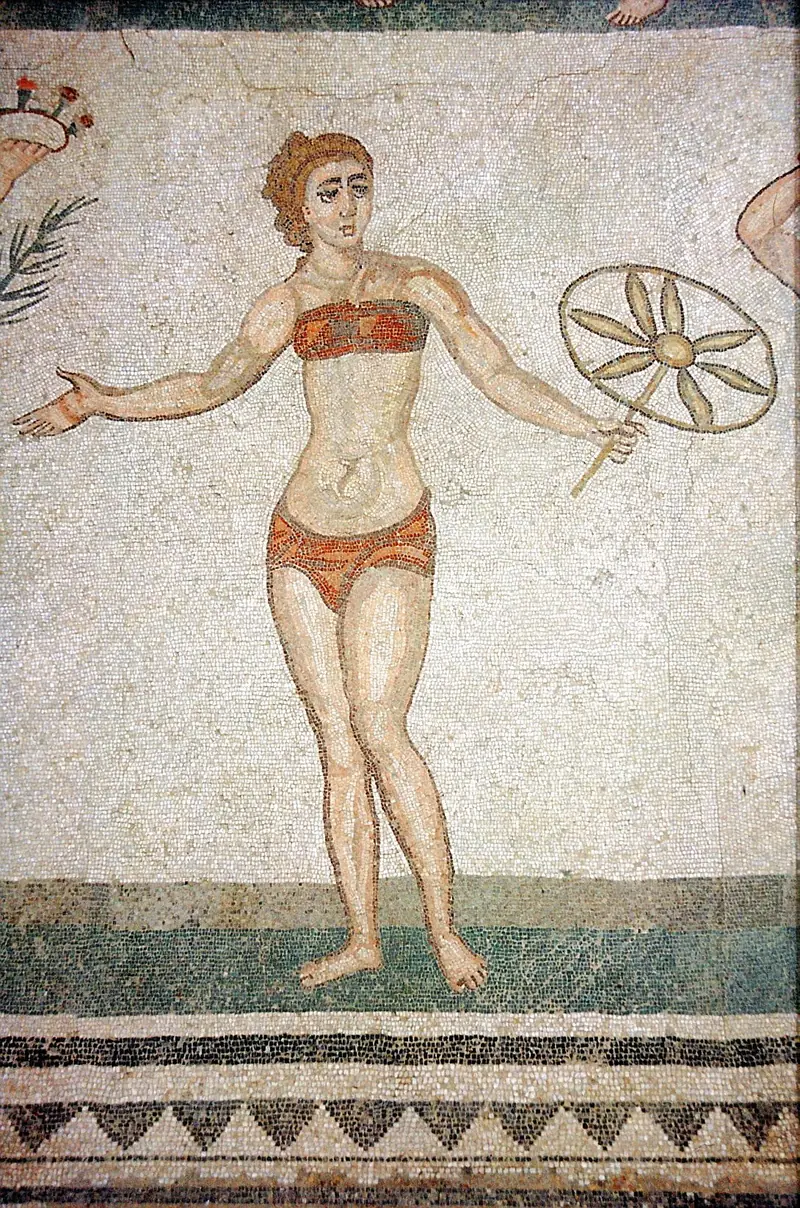
A Roman woman in an “ancient bikini.” Mosaic at Villa Romana del Casale, 4th century A.D.
With the fall of the Roman Empire, the need for “water attire” faded for a long time. In medieval Europe, bathing gave way to fasting and prayer. The traditions of bathing were revived only in the 18th century when the first resorts appeared in England and France. In special bathing houses with separate sections for women and men, people spent time in shallow water and hardly swam, so there was no need for comfortable swimwear.
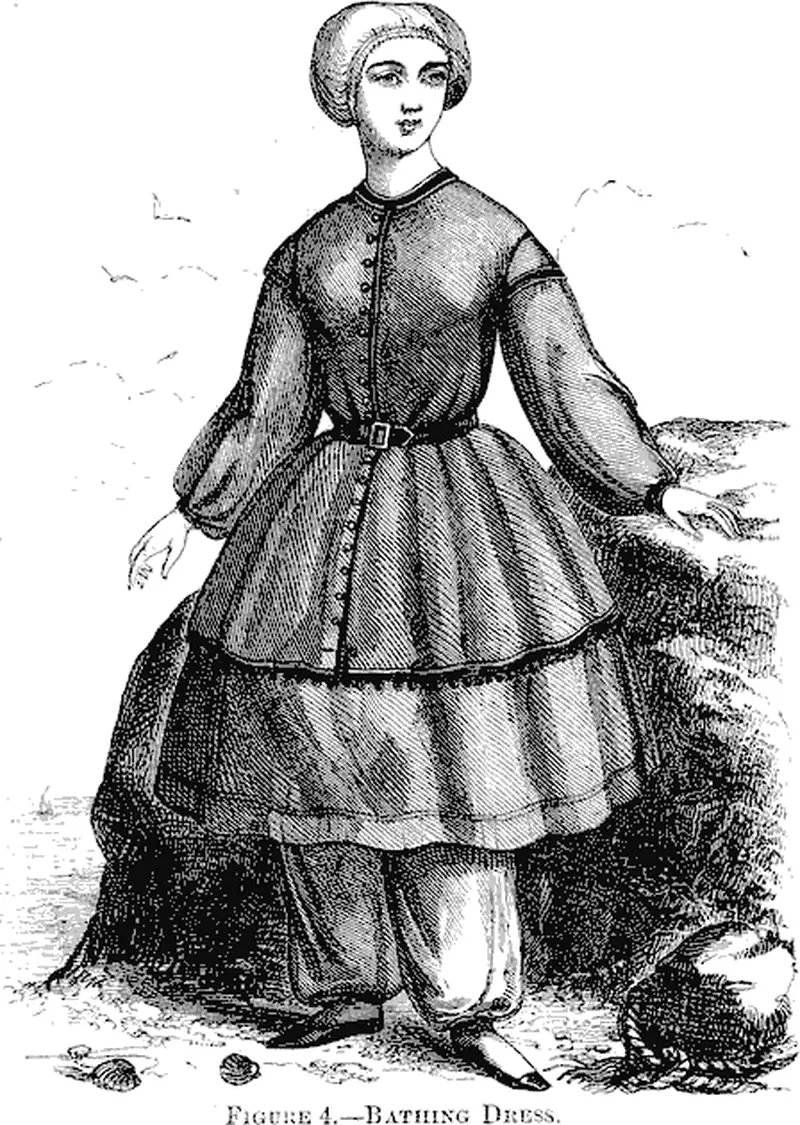
Swimsuit from 1858
Women splashed in the water wearing long dresses with weighted hems, to which special weights were sewn to prevent the fabric from riding up. In addition to these “weights,” bathers wore corsets, thick stockings, textile shoes, and hats. This multilayered “uniform” became even heavier when wet. To ease the experience of bathing, special wheeled contraptions called bathing machines were used to enter the water.

A man and a woman exiting a bathing machine, circa 1910
Beach Gear
With the development of railway connections, the popularity of seaside resorts grew, and by the late 19th century, special clothing for water recreation began to be made. Compared to the heavy dresses of the Victorian era, women’s swimsuits looked like a fashion breakthrough: one could choose either a lightweight tunic with a belt, bathing stockings, and knee-length pantaloons, or a long robe with ties at the neck.
While it was still considered improper for women to enter the water barefoot at public beaches, men enjoyed the water barefoot, wearing striped swimsuits with knee-length legs and elbow-length sleeves. However, after swimming was declared an Olympic sport at the end of the 19th century, the athletic bodies of swimmers in triangular red cotton trunks became a showcase of new trends in men’s beach fashion.
Radical changes also swept through the design of women’s swimsuits. After the heavy dress was split into a jacket and pantaloons in 1860, a lighter model called the “princess” emerged in the 1880s. This design featured wide pants connected at the waist to a blouse, with an additional upper skirt and a cap added to the beach ensemble.
In the 20th century, swimsuits underwent as many transformations as society itself. The upheaval began with the swimsuit of Australian Annette Kellerman. In 1907, the swimmer showcased a women’s version of a men’s swimsuit: a vaudeville outfit intended for a water performance with synchronized swimming elements called “Venus, the Diver.”
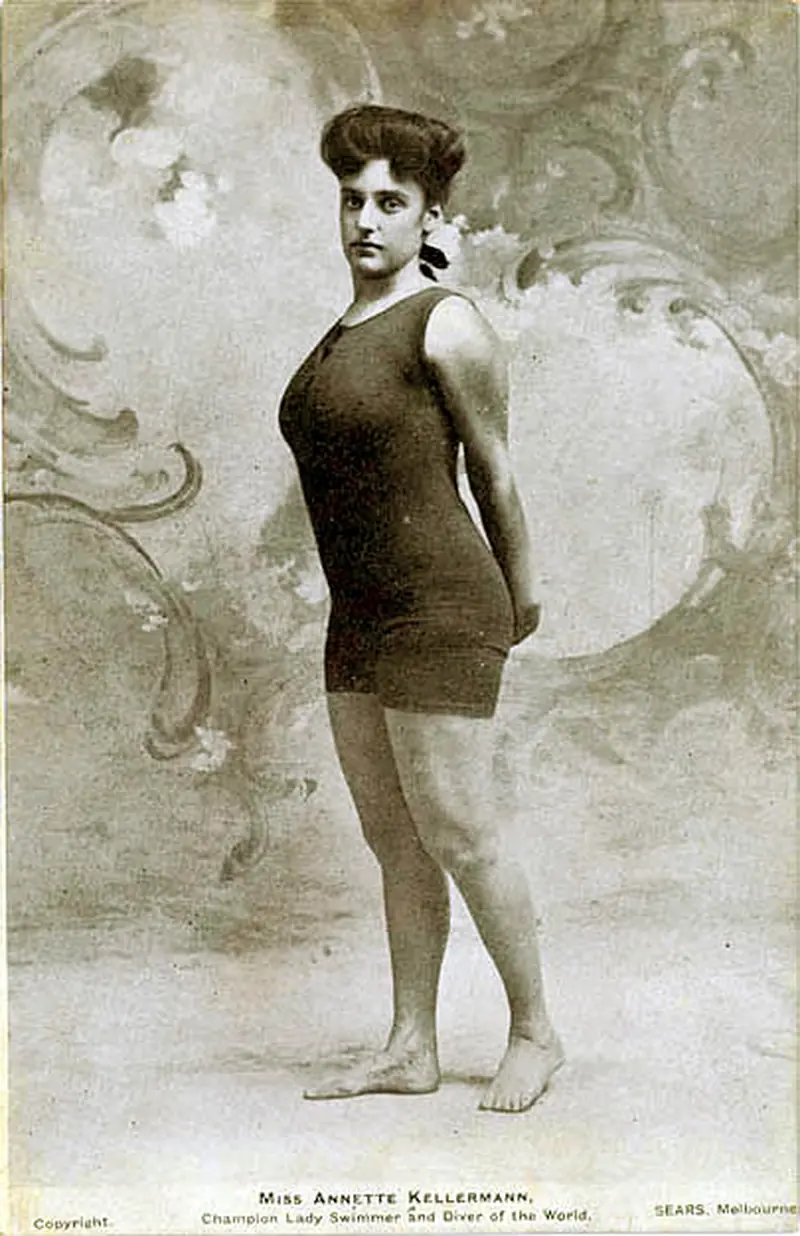
Promotional photo of Annette Kellerman in her own design swimsuit, considered quite daring at the time, circa 1903 – 1913
New Trends
Since it was deemed improper for women to expose their bodies, Kellerman’s stage swimsuit was complemented with sleeves, a collar, and stockings. Nevertheless, her “stunt” was recognized as a breach of public morality. However, many followers emerged in the new beach fashion legislation, and the reform of swimwear was difficult to halt.
The beach vacation boom swept the world in the 1920s, as increasingly open and functional swimsuits were created for popular leisure, becoming sleek and streamlined. Before the invention of synthetic fabrics, pleasant-to-the-skin natural materials like calico and cotton jersey were in vogue.
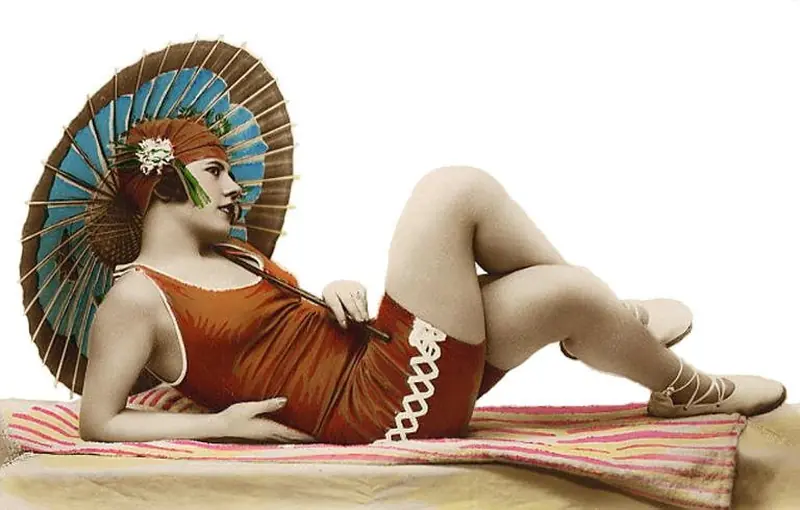
An American woman in a swimsuit, 1920s
The trend of the 1925 swim season was the complete exposure of women’s arms and legs. The swimsuit of French singer Suzy Solidor caused a sensation on the Côte d’Azur and… stirred moralists. To combat the spread of this new fashion, morality patrols were dispatched to the beach: public “controllers” measured the dimensions of women’s swimsuits and penalized violators with hefty fines for deviations from the norm.
In the 1930s, women’s swimsuits were either one-piece suits with wide straps or ensembles of high shorts that covered the navel and modest bras with high backs and wide straps. It was during this time that men’s kayaking shorts emerged—a distant precursor to modern swim trunks, made for an English rower as sportswear. The knitted model made from wool weighed about 11 pounds when wet.
Divide and Conquer
Form-fitting one-piece swimsuits remained fashionable until the late 1930s. “Sheath” swimsuits made women’s figures appear slimmer and attracted men with a certain “unintentional” sexuality (similar to how such swimsuits are perceived on women today). Later, this seductive weapon was favored by the incomparable Marilyn Monroe, who remained loyal to sheath swimsuits despite the new fashion trends of the time.

Marilyn Monroe in a bikini
The first modern two-piece swimsuit was invented by fashion revolutionary Coco Chanel in 1934. From that point on, the swimsuit no longer concealed the female body, becoming a motivation for its owners to enhance their figures. In 1935, American designer Claire McCardell combined the ideas of one-piece and two-piece swimsuits into one model, leaving the sides exposed for the first time.

Claire McCardell’s swimsuit
In contrast to the open and semi-open swimsuit models that “obliged,” a popular beach ensemble in the late 1940s became a variant of the swimsuit with wide shorts that cinched at the top with a drawstring. It looked so natural that it was hard to believe that the design came about by accident—due to a tailor’s mistake.
Finally, on July 5, 1946, the world was stunned by a women’s swimsuit of unprecedented “revealingness.” It consisted of a narrow strip of fabric for the top and equally small bottoms that fully exposed the woman’s navel and even the lower abdomen. The presentation of this scandalous novelty at the fashionable Molinar pool in Paris caused a sensation, and July 5 became etched in the calendar of memorable events as Bikini Day.
The “Explosive” Effect
The mastermind behind this design masterpiece was an automotive engineer. This was the profession of Louis Réard, a French-born American designer who began modeling women’s lingerie in the family business in the 1940s.
While at the beaches of Saint-Tropez, the engineer noticed that women, in their desire to tan better, had to constantly adjust their swimsuits, rolling and tucking them, so he decided to relieve them of this inconvenience. The designer believed it necessary to cut the details of the future swimsuit to the limits dictated by decency.
While Louis Réard holds the patent for the new swimsuit (and it was he who brought his creation to the runway), the model has another “father.” The co-creator of the bikini is considered to be French designer Jacques Heim, who also conceived something similar. In collaboration with Louis Réard, he was responsible for launching the novelty into mass production and suggested the first version of its name. Initially, the world’s smallest swimsuit was called “Atom,” referencing the smallest indivisible particle of matter.
However, before the new model was presented in Paris, the world was shaken by a significant event: in early summer 1946, the American army tested a nuclear bomb on the Bikini Atoll in the Pacific. The creator of the unprecedented swimsuit received a more striking idea for its name—let it be “bikini,” decided the impressed engineer, as both events had an equally explosive effect.
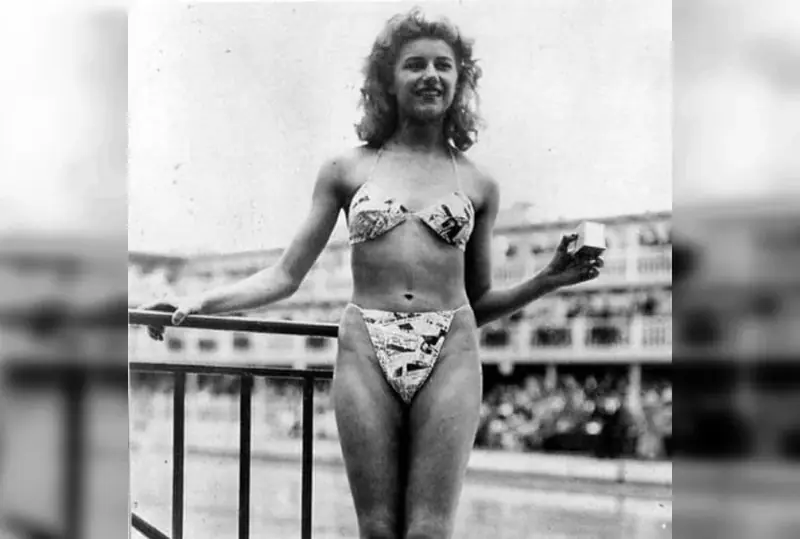
The first public showing of the bikini by nightclub dancer Micheline Bernardini, Paris, 1946
The “Feats” of a Stripper
That the appearance of the bikini would become a global sensation, comparable to the detonation of an atomic bomb, was something the creator of the smallest swimsuit anticipated even during the preparation for the presentation. Not without reason was the advertising slogan for the new textile product: “Bikini is a split atom.” The new model required only a meter of fabric 70 centimeters wide. A unique feature of the model, consisting of two triangles on top and two on the bottom, was that both parts of the swimsuit set could be freely threaded through a ring.
The challenge lay in finding a model to demonstrate such revealing clothing in public. At that time, this was a very bold step, and no model dared to take it. Ultimately, the task was accomplished by a stripper. After appearing in the le bikini swimsuit, nightclub dancer Micheline Bernardini reportedly received 50,000 love confessions and marriage proposals.
In contrast, critics labeled the boldest design ever created by designers at that time as “a slap in the face to public taste.” The Vatican officially deemed the swimsuit immoral. Italy, Spain, and Portugal, influenced by the Catholic Church, imposed bans on its public use. After the “feat” of the stripper was repeated at the first Miss World contest by Swedish representative Kiki Håkansson, who appeared at the awards ceremony in a bikini, Spain and Ireland protested to the organizers and considered withdrawing their participation in the contest.
Contestants for the “Miss World” crown in 1951 were prohibited from parading in bikinis on the grounds that such swimwear gave them an advantage over other participants who would not dare to wear it. Due to mass protests against the use of bikinis by participants in “Miss World,” the contest was moved in 1966 from the Indian city of Bangalore to the Seychelles. Little did the protesters know that in the future, wearing a bikini would become a mandatory part of beauty pageants.
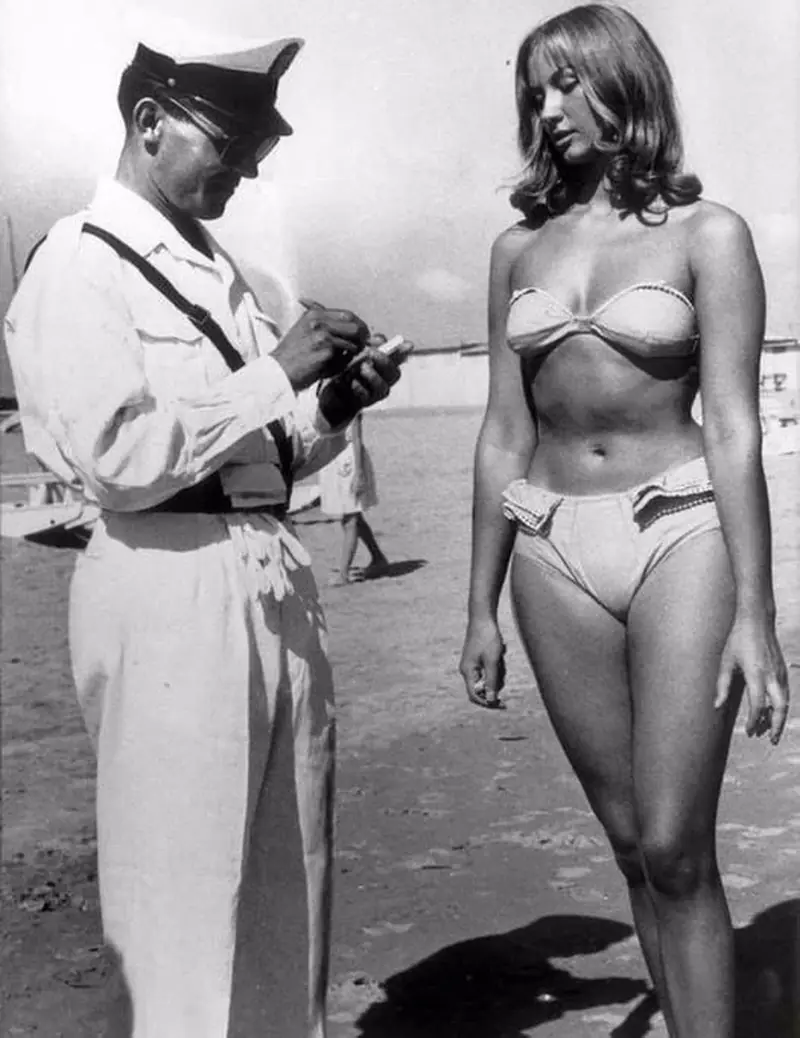
An Italian policeman fines a girl for wearing a bikini on the beach
The Joy of Life
From the very beginning, the curiosity surrounding the unusual swimsuit was observed in war-torn countries, explained by a longing for the peaceful joys of life: European women wanted to hit the beach in “carefree” attire to fully inhale the fresh air of freedom. After the popularization of the bikini in the 1950s, the title of “Miss Elegance 1950” went to Sophia Loren, followed by Hollywood stars Marilyn Monroe and Brigitte Bardot, solidifying the new swimsuit’s victory over its opponents. Despite American moral guardians initially prohibiting Hollywood from advertising bikinis in films, this did not hinder the triumphant march of the revolutionary swimsuit.
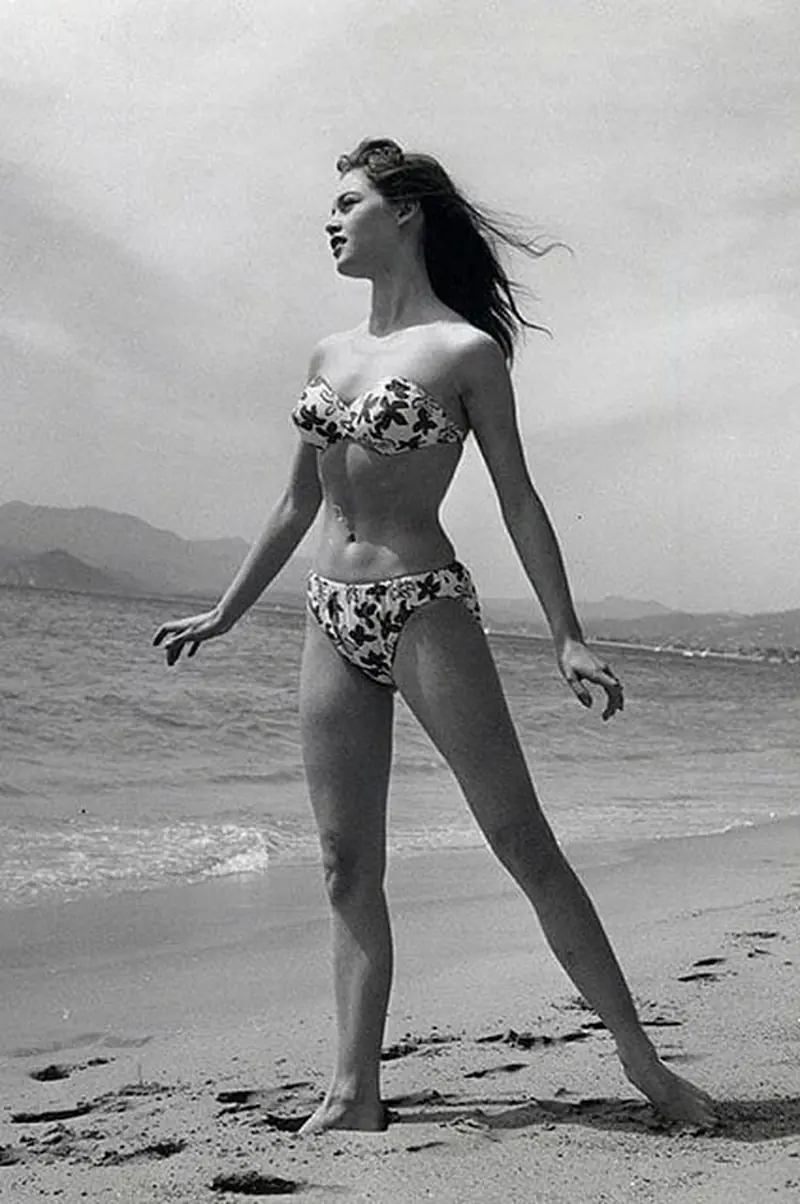
Brigitte Bardot in a bikini
In 1957, bikini sales surged with the release of the cheerful film “And God Created Woman” directed by Roger Vadim: Brigitte Bardot’s beach look was so enchanting that girls around the world copied it, provided their figures allowed. The actress herself donned that alluring swimsuit multiple times for shoots, including for the film “Manina, the Girl in the Bikini.” As for what the bikini meant to Canadian-American actress and model Pamela Anderson, we learned after her role in the TV series “Baywatch”: she even wore her favorite white bikini instead of a dress at her wedding.

Pamela Anderson’s wedding
The next pivotal moment in the history of swimwear came in 1959 with the invention of elastic fiber. This innovation from Dupont made swimming literally lighter: swimsuits made from this new material became smaller in weight. At the same time, garments made from spandex ensured maximum body-hugging fit, retained color longer, and did not lose shape when wet.
Topless tanning swimsuits became symbols of the sexual revolution. In the 1970s, manufacturers even separated the bikini, selling beach bottoms and tops separately. However, the invention of Lycra led to a resurgence in bikini popularity starting in 1974, as it became a versatile swimsuit with modification options.
A Second Wind
Among the variations of the bikini are the men’s sling swimsuit, the mankini (from the English “man bikini”), the model connecting the top and bottom called the monokini (designed by unisex clothing creator Rudy Gernreich in 1964), the trikini (a compromise between two-piece and one-piece swimsuits, being a more revealing version of the monokini), the nanokini made of strings, and even the burkini, a swimsuit draped in fabric from head to toe for Muslim women.
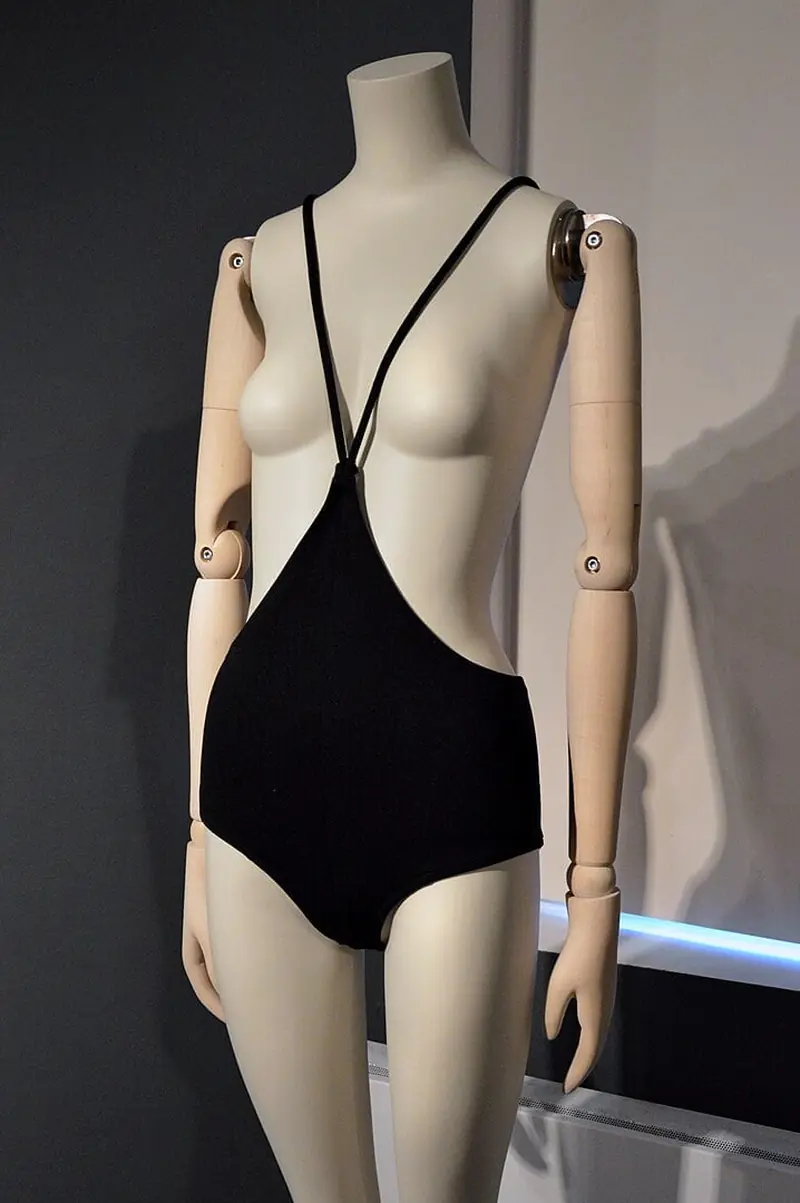
Monokini 1964
The assortment of swimwear innovations has never been exhausted. In the 1970s, beach fashion included thong swimsuits and the dental-floss model (translated from English as “dental floss”): tiny panties with thin straps in the back and a minimalist triangle in the front. The further evolution of swimwear moved towards increased exposure. Nowadays, there are even products that are not sewn garments but simply coverings for certain body parts that need to be shielded from prying eyes.
 The Gillette Venus brand chose plus-size model Anna O’Brien as the face of its advertising campaign.
The Gillette Venus brand chose plus-size model Anna O’Brien as the face of its advertising campaign.
Fashion designers joke that since everything new is just well-forgotten old, it won’t be long before the circle closes completely, and humanity returns to ancient traditions of exposure. This is also supported by the culture of so-called “body positivity,” which dismisses aesthetic standards in body evaluation and embraces “natural” beauty without the need for figure enhancement through clothing. While in the previous generation, women with extra weight and skin imperfections hesitated to wear bikinis, nowadays, no one is stopping anyone.

Could this be related to the “second wind” that provocative models are experiencing today? Given that sales of two-piece swimsuits in the U.S., according to marketing research, have increased by 80% in recent years, bikinis are increasingly being purchased by women over 30. This level of demand has never been seen before. Thus, Bikini Day is becoming an increasingly relevant celebration each year, boosting women’s confidence and extending men’s youth.

